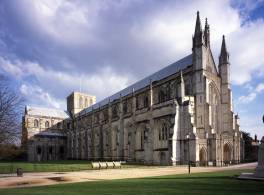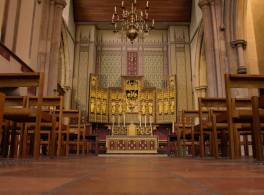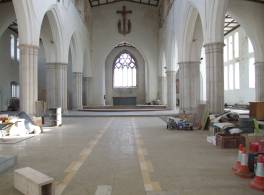There can be a lot of work to do before you apply to your Fabric Advisory Committee or to the Commission.
We can help you increase your chances of success.

Always consult early on
Early consultation offers you a chance to get free expert advice. You should always contact:
- Your Fabric Advisory Committee
- The Commission
- Historic England
- Your local planning authority
- Relevant national amenity societies
- The Association of English Cathedral’s project support panel for major development projects
This can help you identify and negotiate any problems with your proposal early and get everyone to agree on the underlying principles of a project before you’ve spent time and money on detailed designs.
Helpful hint:
Don’t forget to share your aspirations with your congregation and the local community.
This will go a long way towards winning people round to your plans for the future.
Consult the Commission
We may want to organise a site visit and send a delegation from the Commission to discuss the proposal with members of chapter, your professional advisers, and members of your Fabric Advisory Committee. We may also recommend that you invite representatives from Historic England and the national amenity societies.
Our early advice will deal with any aspect of your proposal that we (or the FAC) are unlikely to approve. We may tell you if the application is ready to be made. But our early advice will never say that an application will definitely be approved.
We can also give you helpful, independent advice on applications to other authorities, even when approval under the Measure is not required.
Important:
Views expressed on site by members of the Commission do not constitute the advice of the entire Commission.
You will receive our formal advice in writing following the visit.
Plan ahead
If your project needs formal permission, then you and your architect or archaeologist should put together a timetable leading up to your application.
Think about the time you will need to:
- Prepare your supporting documents (include time to commission them)
- Get advice from your Fabric Advisory Committee, the Commission, and other relevant consultees
- Meet the deadlines of your Fabric Advisory Committee, the Commission, and grant-giving bodies.
Commission reports
Prepare the following documents independently of any specific scheme.
Helpful hint:
Your proposals should also align with your diocesan mission action plan.
Your supporting documents
Always include the following supporting information with your application to your Fabric Advisory Committee or the Commission:
Where appropriate, your application should also include:
- An assessment of the implications that new works may have for the future maintenance and conservation of the fabric
- An options appraisal which looks at alternative solutions, why they were rejected, and the reason you chose the option put forward
- A liturgical statement setting the works in their context: this could be the relevant section of your liturgical plan
- An indication of how the proposals relate to the cathedral’s conservation management plan, together with any relevant sections of the plan
- An indication of how the proposals relate to the cathedral’s visitor engagement plan, together with any relevant section of the plan
- Relevant technical reports, specifications and other detailed information
- A reference to relevant cathedral policies (e.g. art, collections and loans, stone conservation, repairs, etc.)
You must also make your supporting documents available to statutory consultees.
Helpful hint:
Your supporting documents should always be proportionate to the size of your proposal. They should be concise and targeted.
Circulate them electronically.
What do we want to know?
Your supporting information should help us reach a fully-informed view on your proposals. It should address the following questions:
- What work and where?
- Why are you proposing the works? How will they relate to any broader issues the cathedral faces?
- Who is doing the works?
- What impact are they likely to have on the architectural, archaeological, artistic and historic character of the building and its contents?
- How are you mitigating those impacts?
- What are the benefits?
Your checklist for preparing an application
When does the Commission meet?
We meet roughly every six weeks.
Our calendar contains our meeting dates and submission deadlines.
Download our calendar
How long do decisions take?
This varies according to:
- The type and complexity of your proposal
- The Commission’s meeting calendar
- How long it takes to organise a site visit
- How long it takes you to prepare additional information requested by the Commission (if required)
The following is a rough guide:
Next steps
Once you have prepared your supporting information, you need to:
- Find out who to apply to
- Apply to your Fabric Advisory Committee
- Apply to the Commission



